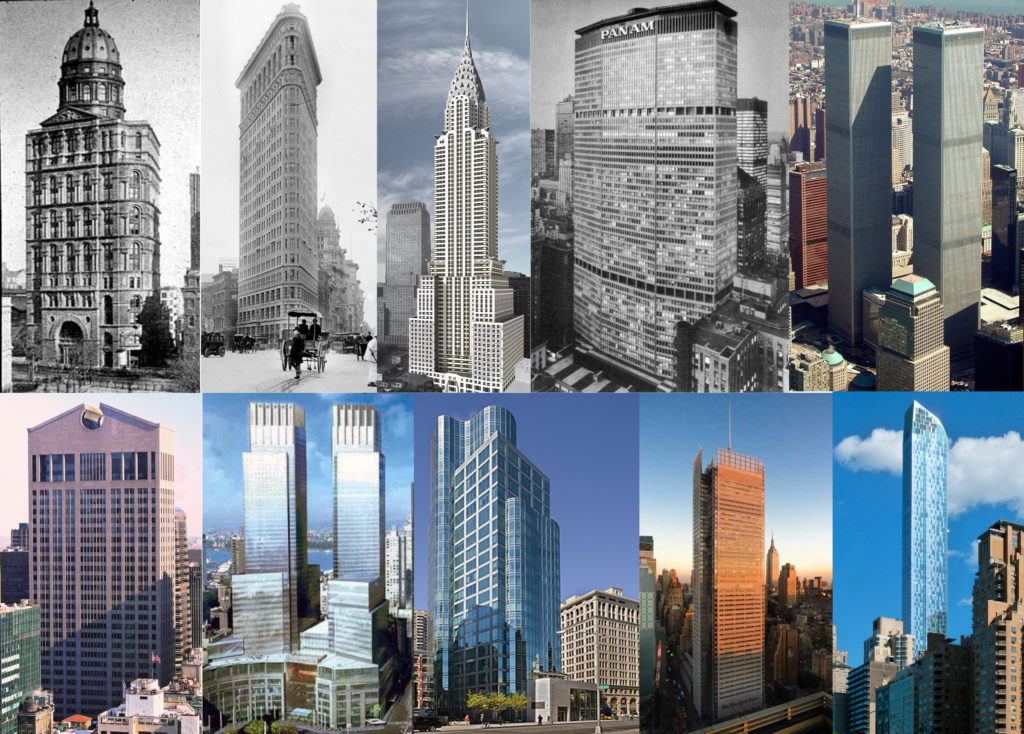Jason M. Barr May 10, 2018
Critics of Manhattan’s new supertall superslim buildings have a laundry list of complaints. One particular trope is that they are ugly and out of scale with their surroundings. While I believe it’s important to debate the pros and cons of tall buildings, it’s also important to keep in mind that today’s beefs continue a 130-year tradition of grousing about skyscrapers.
In this vein, I thought it might be worthwhile to give a short pop quiz. I will give you 10 quotes from architectural critics from 1890 to the present. Try to give (a) the year the quote was made, (b) the name of the architectural critic, and (c) the building under discussion.
The Quiz
Please note a few things. First, the years of the quotes are random, so you cannot infer dates from the order of the questions. Second, each quote was written just around the time the building was completed (or being constructed). Lastly, one quote was made by an anonymous writer.
Ready, set, go!
- “[A] lesson in how to be mediocre without really trying. For its bulk, its importance, its effect, and its ballyhoo, it had an obligation to be much better. Size is not nobility; a monumental deal does not make a monument.”
- “How disappointing for the rest of us, though, that [the company] has built itself a stolid lump of a building, one that encourages the public to treat the architecture the way more and more people are treating their local paper: by ignoring it.”
- “If this [suggested change in design offered by the critic] had been sensitively, that is to say artistically done, would not his building have shown more logic, more organization, more form and comeliness, more variety in a higher unity, than it shows now?”
- “This one unravels as a cascade of clunky curves descending toward ribbons billowing into canopies. The conceit is falling water. The effect: a heap of volumes, not liquid but stolid, chintzily embellished, clad in acres of eye-shadow-blue glass offset by a pox of tinted panes, like age spots. It’s anybody’s guess how the building got past the drawing board.”
- “Such buildings show one of the real dangers of a plutocracy: it gives the masters our civilization an unusual opportunity to exhibit their barbarous egos, with no sense of restraint or shame.”
- “If you don’t look up, you could like this building.”
- “But for thoughtful and refined design, one looks everywhere in vain, and the critic finds himself forced to follow the example of the designer—to ‘cuss the thing and quit it’.”
- “The two buildings offer stunning proof that art and style alone are a ludicrous measure of successful urban architecture; what kind of ‘art’ assassinates a city?”
- “The new building, designed by [the architect], is an elf prancing among men.”
- “As presently designed, this fearful instrument of urbicide will be not only the tallest, but unquestionably one of the, ugliest buildings in the world.”
The Answers
How do you think you did? Here are the answers….
[expander_maker id=”1″ more=”Continue to answers and rest of the blog post” less=”Read Less”]
- 1963, Ada Louis Huxtable, New York Times architecture critic from 1962 to 1983, on the Pan Am (MetLife) Building, just north of Grand Central Station. Article: “Architecture Stumbles On.” New York Times, April 14, 1963, 119.
- 2007, Justin Davidson, New York Magazine architecture critic, on the New York Times Headquarters on West 41st Street.
- 1902, Montgomery Schuyler, critic and journalist, in the Architectural Record, on the Flatiron Building, at Fifth Avenue and 23rd.
- 2013, Michael Kimmelman, New York Times architecture critic, on One57, a luxury condo building on West 57th Street.
- 1931, Lewis Mumford, The New Yorker architecture critic and urban scholar, in the New Republic, on the Chrysler Building. Article: “Notes on Modern Architecture.” The New Republic, March 18, 1931, 119-122.
- 2003, Paul Goldberger, currently the architecture critic at Vanity Fair, in the The New Yorker, on the Time Warner Center, at Columbus Circle.
- 1890, Anonymous, in the Real Estate Record and Builders Guide, on the World Building (demolished) near City Hall.
- 1987, Ada Louise Huxtable, in the New York Times, on the AT&T (Sony) Building and IBM Building in Midtown East. Article: “Creeping Gigantism in Manhattan.” New York Times, March 22, 1987, Section 2.
- 2005, Paul Goldberger, in The New Yorker, on a luxury apartment building on Astor Place.
- 1966, Wolf Von Eckardt, architecture critic for the Washington Post, in Harper’s Magazine, on the Twin Towers at the World Trade Center. Article: “New York’s Trade Center: World’s Tallest Fiasco.” Harper’s Magazine, May 1966, 94-100.

The Spire and the Point
My guess is that, unless you are an architectural historian steeped in the writings of America’s most prominent architecture critics, you had a hard time with this quiz. A phrase here or there, or the writing style, might suggest one time period over another; but there was nothing inherent in any of the quotes to suggest a particular building.
The point is that since day one, skyscrapers have been controversial. Architecture critics seek to provide some indications about whether a building has artistic merit, is new or derivative, achieves the goals of the designer, and/or provides useful urbanism. Naturally, there are buildings that they are going to love and others they are going to hate. To be human is to have an opinion.
But opinions evolve. Take the case of the Pan Am (MetLife) Building. Completed in 1963 it was berated as a monstrous behemoth thrust down amid the Beaux Arts effervescence of Grand Central Terminal and the Helmsely (New York Central) Building. Despite being designed, in part, by Walter Gropius, one the world’s foremost modernist architects, Ada Louise Huxtable, along with many others, hated it for being too large and out of scale with the neighborhood.
Opinions Change
By 2001, however, perceptions reversed. Christopher Gray, author of the Streetscapes column in the New York Times, from 1986 to 2014, aptly quotes John Jurayj, a painter from Brooklyn, who has been involved in preservation efforts:
The old Post Office at the south end of City Hall Park was thought of as garish, and it obstructed a view, and so it was demolished in 1939, but now we’d fight to protect it….It seems that New Yorkers are emotionally connected to what were originally brutal interventions of our skyline. The loss of the World Trade Center shows that buildings that we may not think of as great architecture are important to our sense of ourselves and our city. Aesthetics are dependent upon the passage of time.
Huxtable also hated the AT&T (Sony) Building designed by Philip Johnson (with John Burgee), one of the most creative and influential architects of the 20th century.[1] She saw it as another example of the horrors of Manhattan gigantism; yet today the structure is prized for its style. Philip Johnson, in many respects the quintessential modernist, realized it was time to reject the International Style and hopped on the postmodern bandwagon. His “Chippendale” topped skyscraper is a playful “rebuttal” to the black glass box that dominated the skyline for a quarter century after World War II.
In 2017, protests ensued when the current owner, the Olayan Group, from Saudi Arabia, announced its plans for a large renovation. They want to build a glass curtain wall over the street front and replace a glass arcade and annex building with an outdoor garden. These proposed changes generated opposition; today the building is awaiting a review from the Landmarks Preservation Commission.
New York’s Earlier Skyscrapers
Going back in time a bit (and risking hyperbole), is there anyone alive who does not like the Flatiron Building? Today, it’s one of the most beloved and iconic structures on the planet. When constructed in 1902, however, it was called Burham’s Folly, because it was believed that noted Chicago architect, Daniel Burnham, designed a dud that would topple over in the wind. Disliked by critics, it was seen as rising way out of proportion with the neighborhood. Many found its rounded edges and triangular shape disconcerting.
Then there’s the Chrysler Building. While, at the time, most New Yorkers appreciated its steel spire, sleek gargoyles, and soaring height, Lewis Mumford (1895-1990), one of the most-read architectural critics and urbanists of his day, thought the building was a garish example of egos gone wild. His opinions were not that far off the mainstream thinking about the supertall skyscrapers at the time. In the late 1920s, there were many complaints that the Chrysler and Empire State Buildings were “freak” projects, built, as monuments not money makers, and symbolized the worst of human impulses, all the while imposing rampant congestion on the streets.
Today, we look as these buildings quite fondly, as examples of the glory days of the Roaring Twenties. An era when Babe Ruth was the Sultan of Swat; giddy Flappers were sipping bathtub gin while swinging to the musical stylings of Duke Ellington; and Charles Lindbergh was flying solo across the Atlantic Ocean.
Ugly or Not They Make New York New York
Say what you will about the new skyscrapers going up in New York today. Maybe they are ugly, maybe not. But we can’t use aesthetics as a reason to prevent them from being built. Today’s uglies are tomorrow’s gems. Today’s swans are tomorrow’s crows.
After World War II, New York was derided as a place where skyscraper design was bland and beholden to the developer’s bottom line. We should celebrate the attempts to bring forth original styles and shapes in the 21st century. In the long run, they may succeed or fail, but its the striving to produce the new that makes the city so vibrant. New Yorker’s should once again embrace the power of architecture to enhance not only the look of the skyline but also its culture of creativity.
Just to be clear, I’m not against preservation (and will return to this topic in a future post). I strongly believe a city should preserve some of it historical architecture; and, I believe there is a role for the government regulation of tall buildings. But to suggest they are too ugly, too tall, or out of scale is, in a way, an attempt to clip the wings of New York. The historical buildings that we are most proud of were also the ones that got the same complaints as we hear today.
—————————
[1] Huxtable also complained about the former Huntington Hartford museum (2 Columbus Circle, 1964), disparaging it as a “die-cut Venetian palazzo on lollipops.” Originally designed by Edward Durrell Stone, in 2008 it was renovated and given a new look, but only after calls to landmark it. I personally liked the building before it was changed; it struck me as an example of whimsical modernism with a marble façade, a more pleasing contrast to the cold glass boxes of Midtown.
[/expander_maker]









